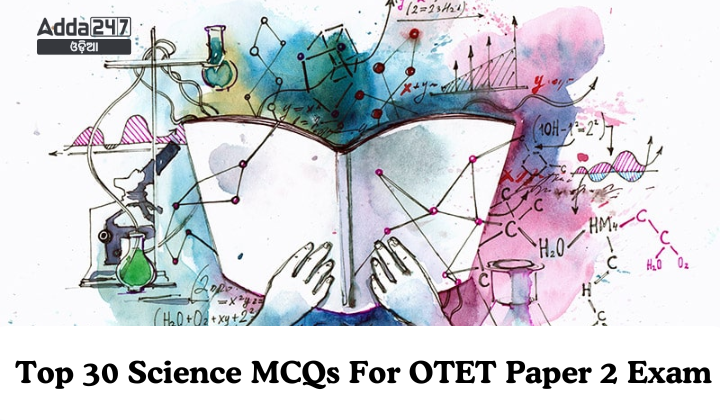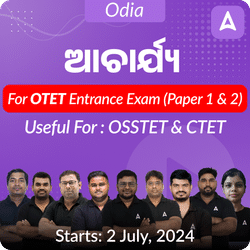Preparing for the Odisha Teacher Eligibility Test (OTET) Paper 2 requires a solid grasp of various subjects, including science. Science questions in OTET Paper 2 often cover a wide range of topics from physics, chemistry, biology, and environmental science. To help you prepare effectively, here’s a curated list of the top 30 multiple-choice questions (MCQs) focusing on science:
Top 30 Science MCQs For OTET Paper 2 Exam
- Which of the following statements about metals is incorrect?
A. Metals are good conductors of electricity.
B. Metals are usually brittle at room temperature.
C. Metals have high melting and boiling points.
D. Metals are malleable and ductile.
Answer: B. Metals are usually brittle at room temperature.
Explanation: Metals are typically malleable (can be hammered into thin sheets) and ductile (can be drawn into wires), not brittle. - Where are metalloids located on the periodic table?
A. Left side
B. Right side
C. Middle
D. Top row
Answer: C. Middle
Explanation: Metalloids are located along the zigzag line between metals (left) and non-metals (right) on the periodic table. - Which of the following elements is a metalloid?
A. Sodium
B. Carbon
C. Silicon
D. Fluorine
Answer: C. Silicon
Explanation: Silicon is a metalloid located in Group 14 of the periodic table. It exhibits both metal-like and non-metal-like properties. - Which property is characteristic of non-metals?
A. High thermal and electrical conductivity
B. Malleability and ductility
C. Brittle when solid
D. High density
Answer: C. Brittle when solid
Explanation: Non-metals are typically brittle when solid and poor conductors of heat and electricity. - Which statement about metals, non-metals, and metalloids is correct?
A. Metals always gain electrons during chemical reactions.
B. Non-metals are located on the left side of the periodic table.
C. Metalloids are neither conductors nor insulators.
D. Metals tend to lose electrons easily.
Answer: D. Metals tend to lose electrons easily.
Explanation: Metals tend to lose electrons to form positive ions during chemical reactions, making them good conductors of electricity. - What are valence electrons?
a. Electrons in the innermost shell
b. Electrons in the outermost shell
c. Electrons in the nucleus
d. Electrons in the middle shell
Answer: b. Electrons in the outermost shell
Explanation: Valence electrons are those electrons in the outermost shell of an atom. They determine the chemical properties and reactivity of the element. - What determines the valency of an atom?
a. Number of protons
b. Number of neutrons
c. Number of valence electrons
d. Number of shells
Answer: c. Number of valence electrons
Explanation: Valency is determined by the number of electrons in the outermost shell of an atom. It dictates how many bonds an atom can form to achieve a stable electron configuration. - What is the general valency of elements in the s-block and p-block of the periodic table?
a. Equal to the number of valence electrons
b. Eight minus the number of valence electrons
c. Always 2 or 3
d. Dependent on the atomic mass
Answer: b. Eight minus the number of valence electrons
Explanation: For s-block and p-block elements, valency is typically calculated as eight minus the number of valence electrons, reflecting their tendency to gain or lose electrons to achieve noble gas configurations. - How do oxidation states vary across a period in the periodic table?
a. Increase then decrease
b. Decrease then increase
c. Remain constant
d. Fluctuate randomly
Answer: a. Increase then decrease
Explanation: Across a period, oxidation states tend to increase initially, reach a maximum, and then decrease towards zero or lower positive states. This trend is due to changes in the electronegativity and ionization energies across the period. - Which statement about oxidation states is correct?
a. Oxygen always has a -2 oxidation state
b. Hydrogen always has a +1 oxidation state
c. Alkali metals have a +2 oxidation state
d. Halogens have a +1 oxidation state
Answer: a. Oxygen always has a -2 oxidation state
Explanation: Oxygen typically exhibits a -2 oxidation state in most compounds (exceptions include peroxides and superoxides). Hydrogen commonly has a +1 oxidation state, and alkali metals like sodium have a +1 oxidation state. - According to Arrhenius, which of the following defines an acid?
a) A substance that turns blue litmus paper red
b) A substance that tastes bitter
c) A substance that releases OH- ions in water
d) A substance that releases H+ ions in water
Answer: d) A substance that releases H+ ions in water
Explanation: Arrhenius defined acids as substances that dissociate in water to release H+ ions. - Which concept of acids and bases explains proton transfer between molecules?
a) Arrhenius concept
b) Bronsted-Lowry concept
c) Lewis concept
d) Faraday’s concept
Answer: b) Bronsted-Lowry concept
Explanation: The Bronsted-Lowry concept defines acids as proton donors and bases as proton acceptors. - Which acid-base pair is correctly matched?
a) HCl and NaOH
b) NH3 and H2SO4
c) H3O+ and OH-
d) Na+ and Cl-
Answer: c) H3O+ and OH-
Explanation: H3O+ (hydronium ion) is the conjugate acid of water, while OH- (hydroxide ion) is the conjugate base. - What is the main limitation of the Arrhenius concept of acids and bases?
a) It cannot explain the basic nature of ammonia
b) It is limited to aqueous solutions
c) It does not consider proton transfer
d) It does not define salts
Answer: b) It is limited to aqueous solutions
Explanation: The Arrhenius concept only applies to substances that dissociate in water to produce H+ or OH- ions. - According to the Lewis concept, which statement is true?
a) Acids donate pairs of electrons
b) Bases accept protons
c) Oxidation-reduction reactions involve proton transfer
d) Non-metal oxides are neutral substances
Answer: a) Acids donate pairs of electrons
Explanation: The Lewis theory defines acids as electron-pair acceptors and bases as electron-pair donors. - What is adaptation?
A. A sudden genetic mutation
B. A short-term change in response to the environment
C. Evolution occurring over millions of years
D. None of the above
Answer: B. A short-term change in response to the environment. - Which of the following is a structural adaptation?
A. Migration
B. Hibernation
C. Camouflage
D. Thick fur
Answer: D. Thick fur. - Which adaptation helps camels survive in deserts?
A. Nocturnal lifestyle
B. Long necks
C. Specialized mode of excretion
D. Conservation of water through reduced sweating
Answer: D. Conservation of water through reduced sweating. - What physiological adaptation helps snakes survive?
A. Ability to produce venom
B. Camouflage
C. Long ears
D. Thick fur
Answer: A. Ability to produce venom. - Which adaptation helps polar bears stay warm?
A. Thick fur and blubber
B. Migration
C. Camouflage
D. Nocturnal behavior
Answer: A. Thick fur and blubber. - What type of adaptation is the ability to climb taller trees to reach sunlight?
A. Structural adaptation
B. Physiological adaptation
C. Behavioral adaptation
D. None of the above
Answer: C. Behavioral adaptation. - Which biome has adaptations like spines and succulent stems in plants?
A. Tropical rainforests
B. Polar regions
C. Deserts
D. Grasslands
Answer: C. Deserts. - Which is a common adaptation in aquatic plants?
A. Dense fur
B. Long roots
C. Thick skin
D. Floating stems
Answer: D. Floating stems. - Which adaptation is found in animals like the cheetah and pronghorn antelope in grasslands?
A. Ability to burrow
B. Speed and agility
C. Ability to climb trees
D. Camouflage
Answer: B. Speed and agility. - What adaptation helps Arctic plants survive in permafrost?
A. Shallow roots
B. Tall stature
C. Leaf shedding
D. Bright colors
Answer: A. Shallow roots. - What is the primary purpose of educational evaluation according to NCF 2000?
A) Assessing students’ academic achievements
B) Providing feedback to teachers
C) Guiding students towards career opportunities
D) Appraising the school’s overall performance
Answer: B) Providing feedback to teachers
Explanation: According to NCF 2000, one of the primary purposes of educational evaluation is to provide feedback to teachers about the effectiveness of their teaching methods. - Which type of evaluation focuses on modifying and improving the program during its development phase?
A) Summative evaluation
B) Continuous evaluation
C) Formative evaluation
D) Diagnostic evaluation
Answer: C) Formative evaluation
Explanation: Formative evaluation involves ongoing assessments and feedback during the instructional process to improve teaching methods and learning experiences. - What characteristic of a good evaluation test ensures that it measures what it intends to measure?
A) Reliability
B) Validity
C) Objectivity
D) Comprehensiveness
Answer: B) Validity
Explanation: Validity ensures that a test accurately measures what it is supposed to measure, aligning with the educational objectives. - According to Patel (1984), evaluation is a continuous process to determine:
A) Achievement of educational goals
B) Effectiveness of learning experiences
C) Both A and B
D) None of the above
Answer: C) Both A and B
Explanation: Patel defines evaluation as a process to determine both the achievement of educational goals and the effectiveness of learning experiences provided in the classroom. - Which evaluation type is comprehensive, covering the entire course content, and is conducted after the completion of the program?
A) Continuous evaluation
B) Diagnostic evaluation
C) Summative evaluation
D) Peer evaluation
Answer: C) Summative evaluation
Explanation: Summative evaluation occurs after the completion of a program and provides judgments about the overall effectiveness of the learning experience and achievement of objectives.










